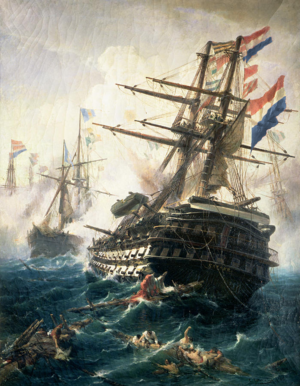Karsk Sea War
This article is incomplete because it is pending further input from participants, or it is a work-in-progress by one author. Please comment on this article's talk page to share your input, comments and questions. Note: To contribute to this article, you may need to seek help from the author(s) of this page. |
| Karsk Sea War | |||||||||
|---|---|---|---|---|---|---|---|---|---|
 Battle of Okhotsk Island (1860), by Ivan Sukhodolski. Oil on canvas, 1901 | |||||||||
| |||||||||
| Belligerents | |||||||||
|
|
| ||||||||
| Commanders and leaders | |||||||||
|
| ||||||||
| Strength | |||||||||
|
Total: 180,300 | ZZ | ||||||||
| Casualties and losses | |||||||||
|
1,542 dead 5,298 wounded 1,860 captured or missing 1,384 killed in action 2,316 died of disease 2,220 wounded | XX | ||||||||
| Events leading to the Great War | ||||||||||||||||||||||||
|---|---|---|---|---|---|---|---|---|---|---|---|---|---|---|---|---|---|---|---|---|---|---|---|---|
 | ||||||||||||||||||||||||
|
||||||||||||||||||||||||
The Karsk Sea War[a] was a military conflict that took place between February 1860 and October 1863 in Central Berea between the Dulebian Empire, later supported by Mascylla, on one side and a coalition of the Lavish Empire, Sarrac and Falland on the other. The war was caused by the rising tensions between Lavaria, a major great power in Berea, and the Dulebian Empire, a rising power at the time, that sought to gain complete control over the Karsk Sea in order to establish itself as continental hegemon, as well as Mascyllary preference to preserve Berea's balance of power. The conflict was the culmination of four decades of rivalry between the two states after the Cuthish Revolutionary War and Alhstead Wars. Between 1858 and 1860, Dulebia grew a powerful navy and began contesting Lavish, Sarracese and Fallish possessions in the Karsk Sea, resulting in a military alliance formed between the latter two states in 1859 (Treaty of Baselle).
The conflict was sparked after a number of provocations by the Dulebian navy and several raids on Fallish merchant shipping on the Okhotsk Archipelago. After an ultimatum to hand the islands to Dulebia, Fallish King Stephen V declared war on Dulebia in the first days of February 1860, soon followed by Sarracese Premier Auguste Dupuis and Lavish King Paulo II, whose presence in the entrance of the sea had a key role in the control of Dulebian imports and exports. Mascyllary Queen Sophia attempted to mediate and arranged a compromise, to which Dulebian Emperor Paul II agreed, but the demand for changes to the agreement by Paulo II led to Paul II recanting and issuing to resolve the conflict through war.
The first months of the war involved only naval warfare in the Karsk Sea: in August 1860 the combined Fallish and Lavish navies were completely destroyed by the Dulebian navy in the Battle of Okhotsk Island, leaving their possessions in the region unprotected. Dulebia used the situation and started several naval invasions on the Okhotsk and later Carra archipelagoes, capturing both island chains and the Fallish fortresses and trading ports based there. After 1861, Dulebia engaged Lavarian forces on the border of the countries, at X and X, with limited to no success. Fearing a Dulebian collapse, Mascylla entered the war against Sarrac, Lavaria, and Falland. After a major Dulebo-Mascyllary invasion in 1863 on the River Lena, and following the bombardment and siege of Aniarro, all three coalition members sued for peace in October 1863, welcomed by Mascylla due to domestic unpopularity of the war.
As a result of the Treaty of Ulich, Dulebia gained full control over the Karsk Sea, forbade Lavaria from basing warships in the sea, and kept two Lavarian duchies captured in the last year of the war (Bravana and Ust-Borovsk). Dulebia also obtained control over the city of Dongdao, a colonial port of Lavaria in Yudong, with the city becoming the second colonial asset of the colonial empire in Eastern Pamira and Mavronesia.
The Karsk Sea War saw the first massive use of several new technologies, including the telegraph, high-explosive naval shells, and new types of medicine. The railways played a vital role in the fighting in Eastern Lavaria, giving the Dulebian side a significant advantage in terms of tactical mobility. The war saw the first massive use of conscript armies by great powers.
The war played a significant role in the history of Dulebia and the Berean continent as a whole. The outcome of the conflict was the establishment of Dulebia as a major power on the continent, and a new rival to the old colonial powers of Falland and Lavaria. The rise of Dulebia followed the previous recovery of the Cuthish Empire as a great power in the Alhstead Wars, a process that shifted the balance of power in Berea and laid the foundations of the future Central Alliance and its counterpart, the Armala Coalition. The rivalry between Dulebia and Lavaria would see a new round that escalated into a full-scale arms race that would continue into the 20th century.